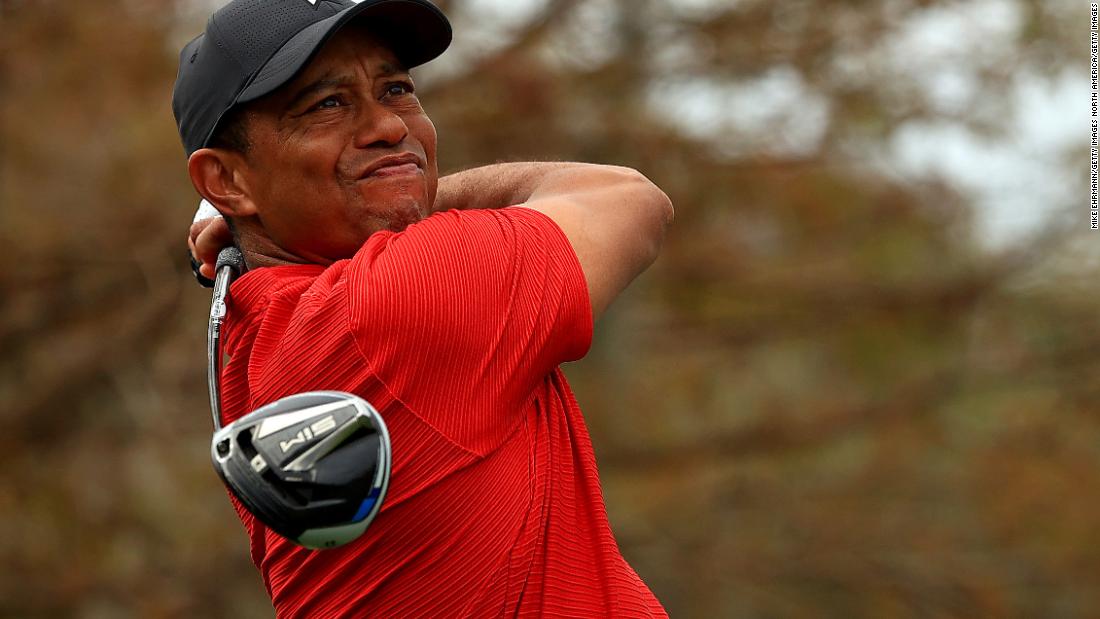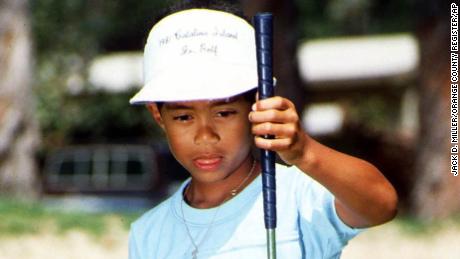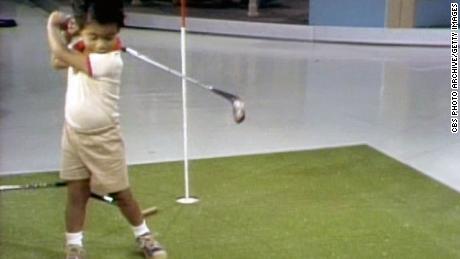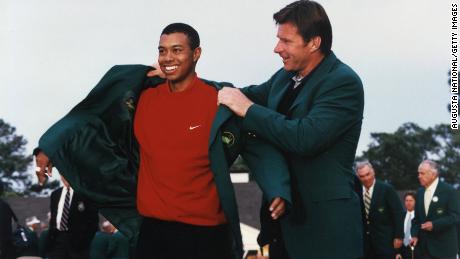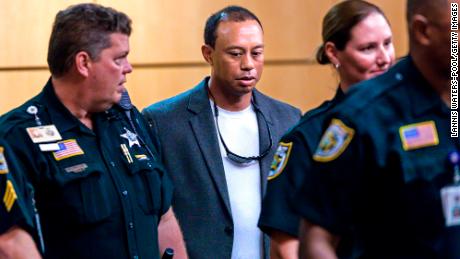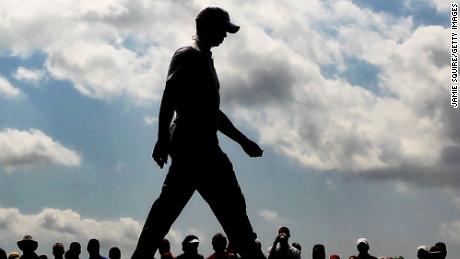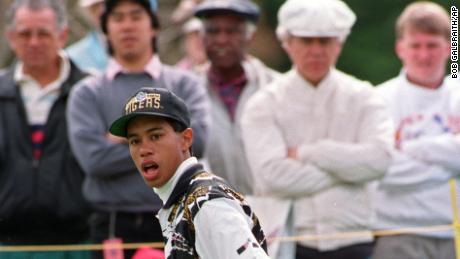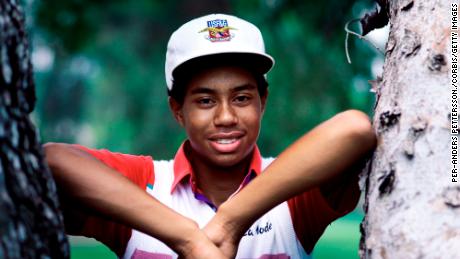And yet, in the same breath, he understood just how different he really was. Asked in the same interview where he could go in the world and not be recognized, he said: “Underwater! That’s why I like diving.”
So, he’s probably not going to like HBO’s new two-part documentary which puts the trajectory of his extraordinary life story under the microscope.
Woods’ agent didn’t immediately respond to CNN’s request for comment.
One of the contributors, the Woods family friend Joe Grohman, agonized before sharing one particularly sensitive detail, saying: “He’s not going to like this sh*t at all.”
‘He’s flawed’
Many will be familiar with the broad strokes of the Woods story: the prophecy of greatness, the ruthless dominance and global stardom, the beautiful family, the spectacular and humiliating fall from grace and the Hollywood comeback of epic proportions.
But how many people understand the nuance and the complexity of the man? The fine details that shaped the arc of his journey. Just how did Woods happen?
One of the co-directors, Matthew Heineman, told CNN Sport that trying to understand Woods presented the kind of challenge that filmmakers crave.
“Like all of us, he’s human; he’s flawed,” said Heineman. “And unlike all of us, his life has played out in the public eye in a way that probably no one else’s life has. Tiger is an incredibly complex person; we want to really embrace that nuance and that complexity.”
Both triumphant and inspirational, it’s also tragic and painful.
Very few of the characters leave Woods’ orbit unscathed , according to the filmmakers. More often than not, they are scarred and discarded, and the viewer will feel sympathy for many of them — even, at times, Woods himself.
“I mean, you can’t help but feel for a guy,” says co-director Matthew Hamachek, “who was thrust into the national spotlight at the age of two.”
Hamachek and Heineman believe that the crux of this story is the relationship between a father and his son. “Earl has this vision for what his son was going to become,” Hamachek added. “It wasn’t just about golf.”
In one particularly awkward TV interview shown in the film, he unwittingly broke the tension by responding to the question “Do you like playing golf?” with the answer: “I want to go poo-poo.”
Testimony from one of his early teachers, Maureen Decker, affirms that a young Woods wanted to try other sports, but his father wouldn’t allow it.
“The world is ready for a non-White golfer to be successful. I have availed Tiger of this, and he takes that responsibility seriously,” Earl declared.
Earl’s vision was that his son would be much more than just a golfer
The film opens with a speech he gave at the Haskins Collegiate Award banquet in 1996, when Earl told the audience: “He will transcend this game and bring to the world a humanitarianism which has never been known before.
“The world will be a better place to live in, by virtue of his existence and his presence.”
‘Creating this robot’
Nonetheless the producers were keen to hear his voice and perspective throughout, and there was no shortage of archived interview material to draw from.
In one clip, Woods dismissed his father’s expectations, saying: “That’s just my Dad speaking, a proud father.”
But Earl was preaching to the world that his son would be little short of the second coming and, once he turned professional, his sponsors were only too happy to continue the sermon.
As Hamachek observed: “It seemed like his entire life people were putting expectations and projecting what they wanted him to be onto Tiger.”
The film presents a narrative that Earl and Kultida — the 15-time major winner’s Mom — raised an automaton capable of handling intense pressure on the golf course, with a ruthless drive for success.
But it seems that they also created an environment which stunted his emotional growth, resulting in an imperfect human. At the height of his powers, Woods seemed to find comfort watching morning cartoons with a bowl of cereal.
Some of the most revealing testimony is provided by his first girlfriend Dina Parr, who says she could see where it was all heading.
“I felt like their plans were creating this robot. There was all this preparation for golf, but he had no life skills. He had not been prepared for life. And I was probably the only person around that really kept him in check.”
Parr says that their relationship ended abruptly when she received a cold and business-like termination letter from Woods, who “never wanted to see or hear” from her again. “I know this is sudden and a surprise, but it is in my opinion much warranted,” wrote the golfer.
Parr was devastated; she said they had been in love and were happy together: “It was like a death, the Tiger that I had known had died. His sweetness was stolen from him.”
Woods had learned golf from his father; he’d learned how to be tough from him, too. Famously, Earl was a green beret in the US military, operating behind enemy lines during two harrowing tours of duty in the horrific Vietnam War.
“He was very worldly and deep in his thinking. My mom was the enforcer. My dad may have been in the Special Forces, but I was never afraid of him. My mom’s still here, and I’m still deathly afraid of her. She’s a very tough, tough old lady, very demanding. She was the hand, she was the one, I love her so much, but she was tough.”
Self-destructive behavior
At the age of 13, according to the documentary, Tiger had apparently been taught to hypnotize himself, to tune out extraneous noise.
As Woods’ own life subsequently spiraled out of control, the details of the story become a little more sordid.
Some conservative viewers may find themselves clutching their pearls by the time he’s cheating on his wife, Elin, with reckless abandon in a church parking lot.
It was a pattern of self-destructive behavior that presented the film’s directors with another challenge — how much should be revealed?
Hamachek and Heineman say they were reluctant to overly sensationalize the details, but nor could they underplay the relevance of them.
They say they recognized that Woods’ children might one day see the film, so every decision in the edit suite was handled with a great deal of care. “It wasn’t going to be TMZ, and it also wasn’t going to be a puff piece,” said Hamachek.
Heineman added: “This is really a psychological portrait of the man through these interviews, and there are details in the show that touch on things that I wouldn’t necessarily want to have revealed about myself. But that is his story and we couldn’t shy away from that.”
Through the insight of Woods’ first love Parr and two family friends, Pete McDaniel and Grohman, the film claims to explain the making of the man.
But it’s through the original testimony of Rachel Uchitel, speaking on camera for the first time, that we see what that man became.
Uchitel , who became a public figure as a result of her relationship with Tiger, sheds new light on a man who was seemingly trying to escape from the pressure of it all, and she found herself in the eye of the storm when their cover was blown.
As a teenager, Parr’s relationship with Woods was ended with a letter; Uchitel says her termination was crafted by a lawyer. His longtime caddie Steve Williams also discovered that friendship with Woods can be revoked at a moment’s notice and there is no going back.
And yet, there doesn’t seem to be any resentment from those who say they were cast aside.
“I think one of the most interesting psychological things is how unbelievably protective they still are,” says Heineman. “There wasn’t anger; there wasn’t bitterness. It was still so much love for this man, even though he might have hurt them deeply.”
Asked what they think the moral of Woods’ story might be, the directors struggle to identify it; because he is such a complex character, he can’t be “put in a box.”
But Hamachek believes that no one has been merely a spectator of his golf or will be a disinterested viewer of this film; everyone has been more involved than that.
“We sort of played a role in cheering him on when he was on the rise, and a lot of people in the public took a great deal of glee in his downfall.
“And then we’re right back there to cheer him on in the comeback. One of the things that I found fascinating about this story is how the public at large is sort of culpable in his story as well.”
“We all projected ourselves onto this man,” says Heineman. “We wanted him to be this perfect poster boy for breaking through and breaking barriers and doing many things, and so when that didn’t happen, our own expectations were broken and our own views of ourselves and our own visions were broken.
“I hope that in watching the show, you can at least feel like you’re in his shoes, [feeling] what that pressure and what that spotlight really feels like.”
Father and son
Just weeks before the film’s release, Woods was back in the news. Or, more pertinently, his 11-year-old son Charlie was in the news — playing golf in public for the first time.
Charlie’s greenside presence, when his Dad won the 2019 Masters to complete his most extraordinary comeback, represented the completion of the father-son arc. Charlie’s emergence as a young, exceptional golfing talent in his own right marks a generational shift and the start of a new chapter.
“It’s quite interesting seeing Charlie and Tiger out there playing together,” says Heineman. “What has he learned as a human being? What has he learned as a father? Because he was taught many lessons by Earl, some of which obviously benefited him greatly, and I think some of which obviously hurt him greatly.”
The 15-time major winner would appear to have learned something else from his father, how to protect the privacy of his children. Whilst Charlie wowed us all with his prodigious talent, he was not made available for interview.
This young man can thank his father for that, but it’s a lesson his Dad was made to learn the hard way.
Dan Kamal contributed to this report.

